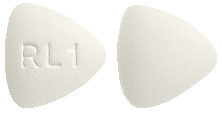1 Name of Medicine
Entecavir monohydrate.
2 Qualitative and Quantitative Composition
Each tablet contains 0.5 mg or 1 mg entecavir (as monohydrate).
Excipients with known effects. Contains sugars as lactose.
For the full list of excipients, see Section 6.1 List of Excipients.
3 Pharmaceutical Form
0.5 mg film-coated tablet is white to off-white, triangular shaped film coated tablets, debossed with 'RL1' on one side and plain on other side.
1.0 mg film-coated tablet is light pink to pink, triangular shaped film coated tablets, debossed with 'RL2' on one side and plain on other side.
4 Clinical Particulars
4.9 Overdose
There is limited experience of entecavir overdosage reported in patients. Healthy participants who received single entecavir doses up to 40 mg or multiple doses up to 20 mg/day for up to 14 days had no increase in or unexpected adverse events. If overdose occurs, the patient must be monitored for evidence of toxicity and standard supportive treatment applied as necessary.
Following a single 1 mg dose of entecavir, a 4-hour haemodialysis session removed approximately 13% of the entecavir dose.
For information on the management of overdose, contact the poisons information centre on 13 11 26 (Australia).
5 Pharmacological Properties
5.3 Preclinical Safety Data
Genotoxicity. Entecavir was not genotoxic in in vitro assays for bacterial gene mutation, cell transformation and DNA repair or in an in vivo micronucleus assay for clastogenicity. High concentrations were clastogenic in vitro in human lymphocyte (> 10 microgram/mL) and mouse L5178Y+/- lymphoma cell (> 28 microgram/mL) assays, with evidence that the L5178Y+/- cell response was related to perturbation of cellular deoxyribonucleotide triphosphate pools.
Carcinogenicity. Two-year carcinogenicity studies with entecavir were conducted in mice and rats. In mice, entecavir was administered orally at 4 dosage levels representing exposure multiples of 1, 2.4, 10 and 34 times human exposure at the 1 mg dose. The doses in rats achieved exposure multiples relative to the human 1 mg dose of < 0.3, 0.3, 3.9 and 29 times and 0.3, 0.6, 3.6 and 20 times in males and females, respectively. Increases in the incidence of lung tumours were observed in male and female mice at exposures ≥ 2.4 times that in humans. Mechanistic studies suggest the lung tumours are likely to be species-specific to mice and probably not relevant to humans. In male rats, entecavir caused pancreatic acinar cell hyperplasia and adenomas at ≥ 3.9 times human exposure. An increase in skin fibromas was seen in female rats at ≥ 3.6 times the exposure in humans at 1 mg/day. The incidence of microglial tumours was increased in rats at and above 0.3 times the exposures in humans at 1 mg/day, reaching statistical significance at 20 times human exposure. Other tumours, which were observed only at exposures ≥ 20 times the exposure in humans at 1 mg/day, included hepatocellular adenomas and/or carcinomas (mice, rates), vascular tumours (mice, rats) salivary duct adenoacanthomas (mice), kidney oncocytoma and malignant mesenchymal tumours (rats) and Zymbal's gland carcinomas (rats; no human counterpart). With the exception of the mouse lung tumours, disruption of cellular deoxyribonucleotide triphosphated (dNTP) pools is likely a significant factor in the carcinogenicity of entecavir, which involves a threshold mechanism. These tumours were generally late appearing and required long-term exposure. Based on animal data, an increased risk of cancer in humans treated with entecavir for an extended period cannot be excluded.
6 Pharmaceutical Particulars
6.7 Physicochemical Properties
Chemical structure.
https://stagingapi.mims.com/au/public/v2/images/fullchemgif/CSENTMON.gif Chemical Name: 2-amino-1,9-dihydro-9- [(1S,3R,4S)-4-hydroxy-3-(hydroxymethyl)-2methylenecyclopentyl]-6H-purin-6-one, monohydrate.
Molecular Formula: C12H15N5O3.H2O.
Molecular Weight: 295.3.
Entecavir monohydrate is a white to off-white powder. It is slightly soluble in water (2.4 mg/mL) and the pH of the saturated solution in water is 7.9 at 25° ± 0.5°C. The partition coefficient log P is -0.81, -1.4 and the pKa in strongest acid is 8 and strongest basic is 2.77.
CAS number. 209216-23-9.
7 Medicine Schedule (Poisons Standard)
S4 - Prescription Only Medicine.
Summary Table of Changes
https://stagingapi.mims.com/au/public/v2/images/fulltablegif/ENTWGRST.gif

